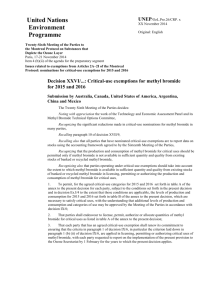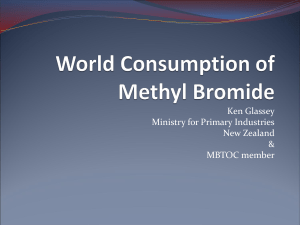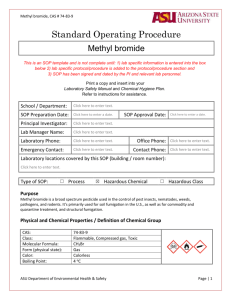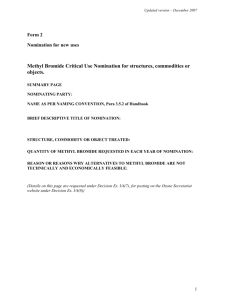ANNEXⅠ: Multilateral Fund for Montreal Protocol Phasing
advertisement
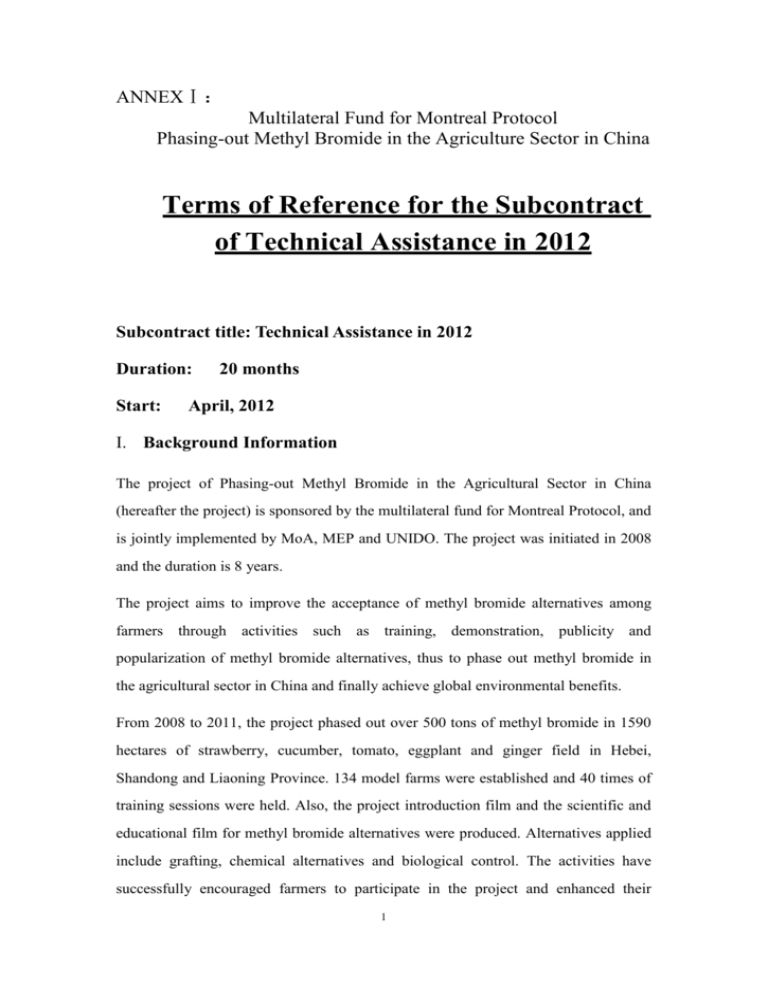
ANNEXⅠ: Multilateral Fund for Montreal Protocol Phasing-out Methyl Bromide in the Agriculture Sector in China Terms of Reference for the Subcontract of Technical Assistance in 2012 Subcontract title: Technical Assistance in 2012 Duration: Start: 20 months April, 2012 I. Background Information The project of Phasing-out Methyl Bromide in the Agricultural Sector in China (hereafter the project) is sponsored by the multilateral fund for Montreal Protocol, and is jointly implemented by MoA, MEP and UNIDO. The project was initiated in 2008 and the duration is 8 years. The project aims to improve the acceptance of methyl bromide alternatives among farmers through activities such as training, demonstration, publicity and popularization of methyl bromide alternatives, thus to phase out methyl bromide in the agricultural sector in China and finally achieve global environmental benefits. From 2008 to 2011, the project phased out over 500 tons of methyl bromide in 1590 hectares of strawberry, cucumber, tomato, eggplant and ginger field in Hebei, Shandong and Liaoning Province. 134 model farms were established and 40 times of training sessions were held. Also, the project introduction film and the scientific and educational film for methyl bromide alternatives were produced. Alternatives applied include grafting, chemical alternatives and biological control. The activities have successfully encouraged farmers to participate in the project and enhanced their 1 awareness of ozone layer protection. In 2012, the project plans to phase out 43 tons of methyl bromide in ginger sector in Shandong Province, to establish 16 model farms and to treat 107.5 hectare of fields. However, phasing-out of methyl bromide in agriculture sector is professional work with strict requirements on the specification of equipment, alternatives and applications. Besides, there are difficulties such as that the main diseases and pests in ginger are not identified, the alternatives are not mature and the poor education of most farmers etc. Therefore, the subcontractor should provide integrated technical assistance, including identifying the equipment specification, formulating the Integrated Pest Management (IPM) plan, developing demonstration and publicity manuals training and the procurement of chemicals etc., to accelerate the project implementation. II. Tasks Description There are five tasks under this subcontract: identifying the equipment specification, establishing model farms for phasing out methyl bromide in ginger sector, formulating the Integrated Pest Management (IPM) plan, developing demonstration and publicity manuals training and the procurement of chemicals. Task 1: Identify the equipment specification Identify specifications for equipment and chemicals Based on the procurement list of equipment and chemicals in 2012 work plan, and refer to the product standards, identify the equipment and chemicals specifications, which used for the purchase Identify technical requirements for the research and development (R&D) of chemical application machines Identify technical requirements for the performance of machines and materials on the basis of the physicochemical characteristics of chloropicrin, dazomet etc. and their applications. Then compile the technical requirement for solid and liquid chemical application machines to support R&D of solid and liquid chemical application machines. Outputs: 2 i. Specifications for equipment and chemicals in 2012 ii. Technical requirements for solid and liquid chemical application machines Task 2: Establish model farms for methyl bromide alternatives in ginger Considering the international commercialized methyl bromide alternatives and the maturity of alternatives in China, the subcontractor should establish 16 model farms for methyl bromide alternatives in Shandong Province. The main activities are: The subcontractor should identify 16 model farms (4 model farms respectively in Anqiu, Laiwu, Laizhou and Longkou) according to the selection rules (ie① Locate in core areas in the areas with intensive plantation of ginger;②The households have some knowledge of soil fumigation and capabilities to learn new knowledge;③With typical soil diseases or pests;④The households are willing to demonstrate the effects to other households.)and the recommendations made by Shandong agricultural environmental protection station (Shandong AEPS). Considering the international development of alternative and the situation in China, the alternatives for 2012 are chloropicrin, dazomet and organic fertilizer. The subcontractor should design the demonstration plan and implement it in the model farm. The subcontractor should sample and analyze the soils in the model farms to identify the main soil borne diseases and pests in ginger sector. After comparing the effects of alternatives on diseases, pests, crop growth and yields, evaluate the effectiveness of different alternatives. Outputs: i. The demonstration plan for methyl bromide alternatives ii. The evaluation report for the effects of different alternatives in ginger Task 3: Formulate the Integrated Pest Manage (IPM) plan and implement it Investigation activities i. The subcontractor should investigate the pest management technologies in ginger in Laiwu, Anqiu, Laizhou and Longkou in in Shandong province. ii. The subcontractor should cooperate with international experts to evaluate the existing chemical and non-chemical pest management technologies besides practical pest management technologies used by farmers in ginger. Compile IPM plan The subcontractor should isolate and identify the pathogens and pests in the soil of Laiwu, Anqiu, Laizhou and Longkou in Shandong province and make practical local IPM plans. Organize a workshop for IPM plan 3 The subcontractor should invite national and international experts to evaluate the IPM plans and the work plan for the next step and submit recommendations. Demonstrate the IPM plans i. The subcontractor should demonstrate the IPM plans in the model farms at Laiwu, Anqiu, Laizhou and Longkou in Shandong province (at least 3 model farms in each key area); monitor the effects and compare with traditional technologies; analyze the effects of IPM plans and the economic and technological feasibility. Outputs: i. The investigation and evaluation report on soil borne diseases and pests in ginger and existing pest management technologies. ii. The IPM plans iii. Experts suggestions on IPM plans iv. The report on IPM plans demonstration Task 4: Develop publicity manuals and organize trainings The subcontractor should compile and print publicity manuals for strawberry, tomato and cucumber respectively. The subcontractor should compile and print training manuals for agro-technicians and farmers respectively. The subcontractor should provide teachers for trainings of project management officers, agro-technicians, farmers and monitoring staff. Outputs: i. Manuals for methyl bromide alternatives in strawberry, 2000 copies. ii. Manuals for methyl bromide alternatives in tomato, 2000 copies. iii. Manuals for methyl bromide alternatives in cucumber, 2000 copies. iv. Training method manuals for agro-technicians, 500 copies. v. Training method manuals for farmers, 1000 copies. Task 5: Purchase chemicals and equipment The subcontractor should purchase the necessary chemicals and equipment for model farms according to UNIDO procurement rules and the PMO requirements. NO. Items Units 1 1,3-D ton 0.10 2 Methyl bromide ton 0.20 3 PIF film ton 1.00 Amounts Task 6: Provide technical assistance for the following activities in the project Assist international experts in the work in China 4 i. Draft the schedules ii. Assist PMO in organizing related activities involve international experts Offer technical consulting services for any other activities in the project Accomplish other tasks assigned by the PMO. Notes: i. All of the activities should be recorded as papers, photos, videos etc., all of the records should be submitted to PMO. ii. The publicity manuals for strawberry, tomato and cucumber and the training manuals for agro-technicians and farmers should be reviewed by PMO and FECO/MEP before print. III. Expected Outputs and Schedule The subcontractor should accomplish the following outputs and submit relevant reports to the PMO (hard copies and electronic versions). NO. 1 Outputs Schedule Requirements Implementation plans Week 2 Both English and Chinese versions 2 Specifications of chemicals and equipment in 2012 Month 1 Both English and Chinese versions 3 Technical requirements for solid and liquid application machines Month 1 Both English and Chinese versions 4 The demonstration plan of methyl bromide alternatives Month 2 Both English and Chinese versions Manuals for methyl bromide alternatives in strawberry, 2000 copies Month 6 Manuals for methyl bromide alternatives in tomato, 2000 copies Month 6 Manuals for methyl bromide alternatives in cucumber, 2000 copies Month 6 5 6 7 Chinese version Chinese version Chinese version 8 The first progress report 9 Training method manuals for agro-technicians, 500 copies Month 7 Training method manuals for farmers, 1000 Month 7 10 Month 6 5 Both English and Chinese versions Chinese version Chinese version copies 11 The survey and evaluation report of diseases and pests in ginger and the control methods Month 8 Both English and Chinese versions 12 The evaluation report for methyl bromide alternatives in ginger Month 9 Both English and Chinese versions 13 The IPM plans Month 10 Both English and Chinese versions 14 Experts suggestions for IPM plans Month 11 Chinese version 15 The second progress report Month 11 Both English and Chinese versions 16 The report of the demonstration of IPM plans Month 12 Both English and Chinese versions 17 The final report Month 20 Both English and Chinese versions Notes: i. Implementation plans should include the implementation plans for the tasks and the schedules. ii. The subcontractor should summarize the implementation status and the outputs to date in the first progress report. iii. The subcontractor should summarize the implementation and outputs of the entire subcontract in the final report. IV. Qualifications i. The subcontractor should have at least 5 years experiences in phasing out methyl bromide. ii. The experts of the team should have sufficient experiences in international cooperation, e.g. as one of the main cooperators, the subcontractor should have accomplished at least 2 international cooperation projects. iii. The subcontractor should have the information of the latest international progress of methyl bromide alternatives. iv. The team leader should have an in-depth understanding about relevant policies of phasing-out methyl bromide in the agricultural sector formulated by the Chinese government and UNIDO, as well as be familiar with the actual situation and macro-operational environment of phasing-out methyl bromide in agricultural sector in China. 6 v. The subcontractor should be familiar with the formulation method of IPM plan in the world, have ability to carry out all tasks described in the subcontract. vi. The team leader should have excellent consulting, communication, coordination and writing skills and abilities. vii. The professional expertise and background of key team members should well cover the requirements of tasks defined in the TOR, e.g. pesticide, plant pathology and soil etc. 7

